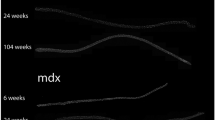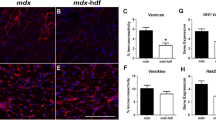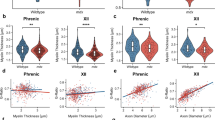Abstract
ALTHOUGH murine X-linked muscular dystrophy (mdx) and Duchenne muscular dystrophy (DMD) are genetically homologous and both characterized by a complete absence of dystrophin1,2, the limb muscles of adult mdx mice suffer neither the detectable weakness nor the progressive degeneration that are features of DMD3–8. Here we show that the mdx mouse diaphragm exhibits a pattern of degeneration, fibrosis and severe functional deficit comparable to that of DMD limb muscle, although adult mice show no overt respiratory impairment. Progressive functional changes include reductions in strength (to 13.5% of control by two years of age), elasticity, twitch speed and fibre length. The collagen density rises to at least seven times that of control diaphragm and ten times that of mdx hind-limb muscle. By 1.5 years of age, similar but less severe histological changes emerge in the accessory muscles of respiration. On the basis of these findings, we propose that dystrophin deficiency alters the threshold for work-induced injury. Our data provide a quantitative framework for studying the pathogenesis of dystrophy and extend the application of the mdx mouse as an animal model.
This is a preview of subscription content, access via your institution
Access options
Subscribe to this journal
Receive 51 print issues and online access
$199.00 per year
only $3.90 per issue
Buy this article
- Purchase on Springer Link
- Instant access to full article PDF
Prices may be subject to local taxes which are calculated during checkout
Similar content being viewed by others

References
Hoffman, E. P., Brown, R. H. & Kunkel, L. M. Cell 51, 919–928 (1987).
Sicinski, P. et al. Science 244, 1578–1580 (1989).
Dangain, J. & Vrbova, G. Muscle & Nerve 7, 700–704 (1984).
Coulton, G. R., Curtin, N. A., Morgan, J. E. & Partridge, T. A. Neuropath. appl. Neurobiol. 14, 53–70 (1988).
Coulton, G. R., Curtin, N. A., Morgan, J. E. & Partridge, T. A. Neuropath. appl. Neurobiol. 14, 299–314 (1988).
Anderson, J. E., Bressler, B. H. & Ovalle, W. K. J. Muscle Res. Cell Motil. 9, 499–515 (1988).
Mandel, J. L. Nature 339, 584–586 (1989).
DiMario, J., Buffinger, N., Yamada, S. & Strohman, R. C. Science 244, 688–690 (1989).
Switzer, B. R. & Summer, G. K. Analyt. Biochem. 39, 487–491 (1971).
Narusawa, M. et al. J. Cell Biol. 104, 447–459 (1987).
Webster, C., Silberstein, L., Hays, A. P. & Blau, H. M. Cell 52, 503–513 (1988).
Kelly, A. M. Devl. Biol. 65, 1–10 (1978).
Schmalbruch, H. & Hellhammer, U. Anat. Ftec. 189, 169–176 (1977).
Dusterhoft, S., Yablonka-Reuveni, Z. & Pette, D. Differentiation 45, 185–191 (1990).
Griffiths, R. I. J. Neurosci. Meth. 21, 159–165 (1987).
Newman, S. et al. J. appl. Physiol. 56, 753–764 (1984).
Smith, P. E. M. et al. New Engl. J. Med. 316, 1197–1204 (1987).
Partridge, T. A., Morgan, J. E., Coulton, G. R., Hoffman, E. P. & Kunkel, L. M. Nature 337, 176–9 (1989).
Wolff, J. A. et al. Science 247, 1465–1468 (1990).
Lee, C. C., Pearlman, J. A., Chamberlain, J. S. & Caskey, C. T. Nature 349, 334–336 (1991).
Menke, A. & Jockusch, H. Nature 349, 69–71 (1991).
McCully, K. K. & Chance B., in Respiratory Muscles and Their Neuromotor Control 317–326 (Liss; New York, 1987).
Kasper, C. E., White, T. P. & Maxwell, L. C. J. appl. Physiol. 68, 533–539 (1990).
Stahl, W. R. J. appl. Physiol. 22, 453–460 (1967).
Syme, D. A. J. Physiol. Lond. 424, 301–315 (1990).
Author information
Authors and Affiliations
Rights and permissions
About this article
Cite this article
Stedman, H., Sweeney, H., Shrager, J. et al. The mdx mouse diaphragm reproduces the degenerative changes of Duchenne muscular dystrophy. Nature 352, 536–539 (1991). https://doi.org/10.1038/352536a0
Received:
Accepted:
Issue Date:
DOI: https://doi.org/10.1038/352536a0
This article is cited by
-
N-terminal titin fragment: a non-invasive, pharmacodynamic biomarker for microdystrophin efficacy
Skeletal Muscle (2024)
-
Nanoparticles systemically biodistribute to regenerating skeletal muscle in DMD
Journal of Nanobiotechnology (2023)
-
Simultaneous assessment of lung morphology and respiratory motion in retrospectively gated in-vivo microCT of free breathing anesthetized mice
Scientific Reports (2022)
-
Early Myocardial Dysfunction and Benefits of Cardiac Treatment in Young X-Linked Duchenne Muscular Dystrophy Mice
Cardiovascular Drugs and Therapy (2022)
-
Duchenne muscular dystrophy
Nature Reviews Disease Primers (2021)
Comments
By submitting a comment you agree to abide by our Terms and Community Guidelines. If you find something abusive or that does not comply with our terms or guidelines please flag it as inappropriate.


